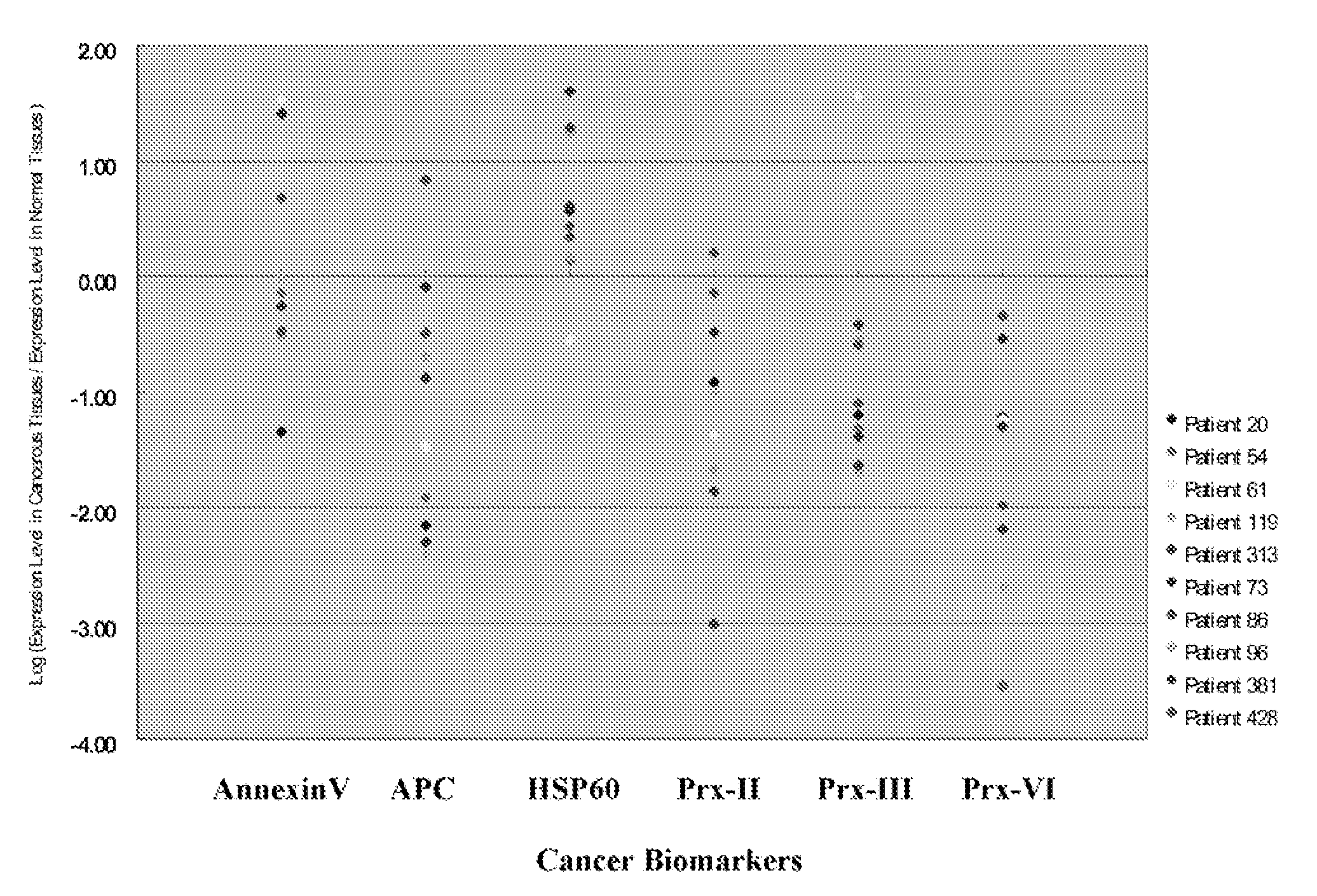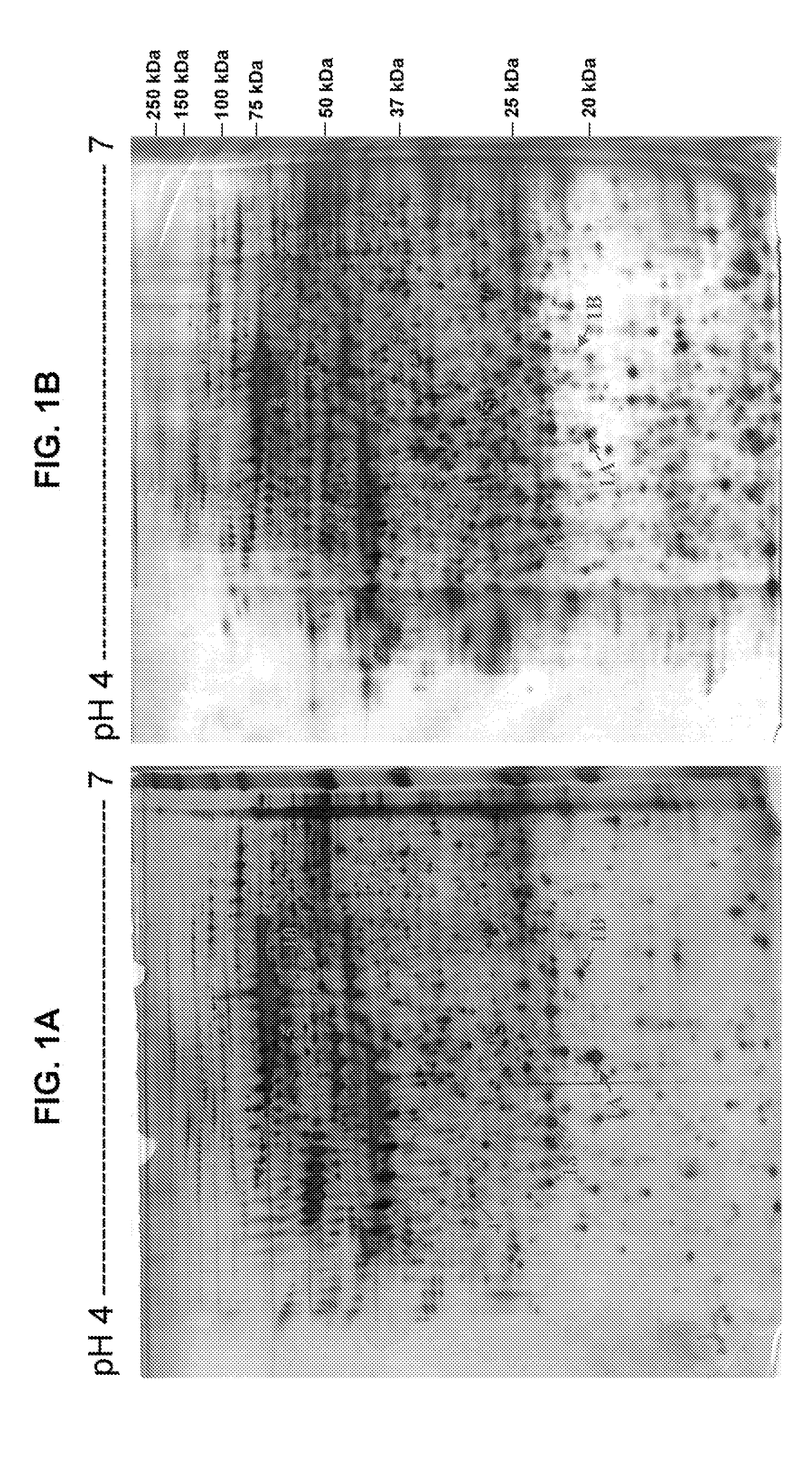Use of biomarkers for the diagnosis and prognosis of lung cancer
a biomarker and lung cancer technology, applied in the field of lung cancer diagnosis and prognosis, can solve the problems of high mortality, no reliable early detection method, and concomitant changes in protein expression
- Summary
- Abstract
- Description
- Claims
- Application Information
AI Technical Summary
Benefits of technology
Problems solved by technology
Method used
Image
Examples
examples 1
Expression of Amyloid P Component in NSCLC Tissues and its Adjacent Non-Tumor Tissues
[0183]An immunoreactive band for amyloid P component (APC) with an apparent molecular weight of about 25 kDa was specifically detected in tumor (T) and non-tumor tissues (N), as shown in FIG. 21A. The band intensities were quantified by their black light units (BLU). The relative expression level of amyloid P component was normalized equally by the internal control, β-actin in either tumor tissues or the paired non-tumor tissues prior to comparison. This was because the lung tissue samples had various degrees of haemolysis, and the amounts of stable expressed tissue protein, β-actin, may vary greatly in the analyzed tissue samples.
[0184]After normalizing with β-actin, the relative expression level of amyloid P component was reduced with more than 1.5-fold in eight of out ten tumors analyzed when compared to the adjacent non-tumor tissues, as depicted in FIG. 21B. Only one of the samples, patient no....
example 2
Expression of Chaperonin in NSCLC Tissues and its Adjacent Non-Tumor Tissues
[0186]An immunoreactive band for chaperonin with an apparent molecular weight of about 60 kDa was specifically detected in tumor (T) and non-tumor tissues (N), as shown in FIG. 22A. The relative expression level of chaperonin was normalized equally by the internal control, β-actin in either tumor tissues or the paired non-tumor tissues prior to comparison.
[0187]The relative expression level of chaperonin was increased with more than 1.5-fold in seven out of ten tumors analyzed when compared to the adjacent non-tumor tissues, as depicted in FIG. 22B. A decreased expression was only found in one of the samples, patient no. 61. No significant changes were observed in patient nos. 54 and 96.
[0188]The data has therefore shown that chaperonin may be used as a biomarker for identifying, diagnosing, and monitoring cancerous lung tissues.
example 3
Expression of Peroxiredoxin II in NSCLC Tissues and its Adjacent Non-Tumor Tissues
[0189]An immunoreactive band for peroxiredoxin II with an apparent molecular weight of about 25 kDa was specifically detected in tumor (T) and non-tumor tissues (N), as shown in FIG. 23A. The relative expression level of peroxiredoxin II was normalized equally by the internal control, β-actin in either tumor tissues or the paired non-tumor tissues prior to comparison.
[0190]The relative expression level of peroxiredoxin II was decreased with more than 1.5-fold in eight out of ten tumors analyzed when compared to the adjacent non-tumor tissues, as depicted in FIG. 23B. No significant changes were observed in patient nos. 86 and 428.
[0191]The data has therefore shown that peroxiredoxin II may be used as a biomarker for identifying, diagnosing, and monitoring cancerous lung tissues.
PUM
| Property | Measurement | Unit |
|---|---|---|
| molecular weight | aaaaa | aaaaa |
| molecular weight | aaaaa | aaaaa |
| molecular weight | aaaaa | aaaaa |
Abstract
Description
Claims
Application Information
 Login to View More
Login to View More - R&D
- Intellectual Property
- Life Sciences
- Materials
- Tech Scout
- Unparalleled Data Quality
- Higher Quality Content
- 60% Fewer Hallucinations
Browse by: Latest US Patents, China's latest patents, Technical Efficacy Thesaurus, Application Domain, Technology Topic, Popular Technical Reports.
© 2025 PatSnap. All rights reserved.Legal|Privacy policy|Modern Slavery Act Transparency Statement|Sitemap|About US| Contact US: help@patsnap.com



